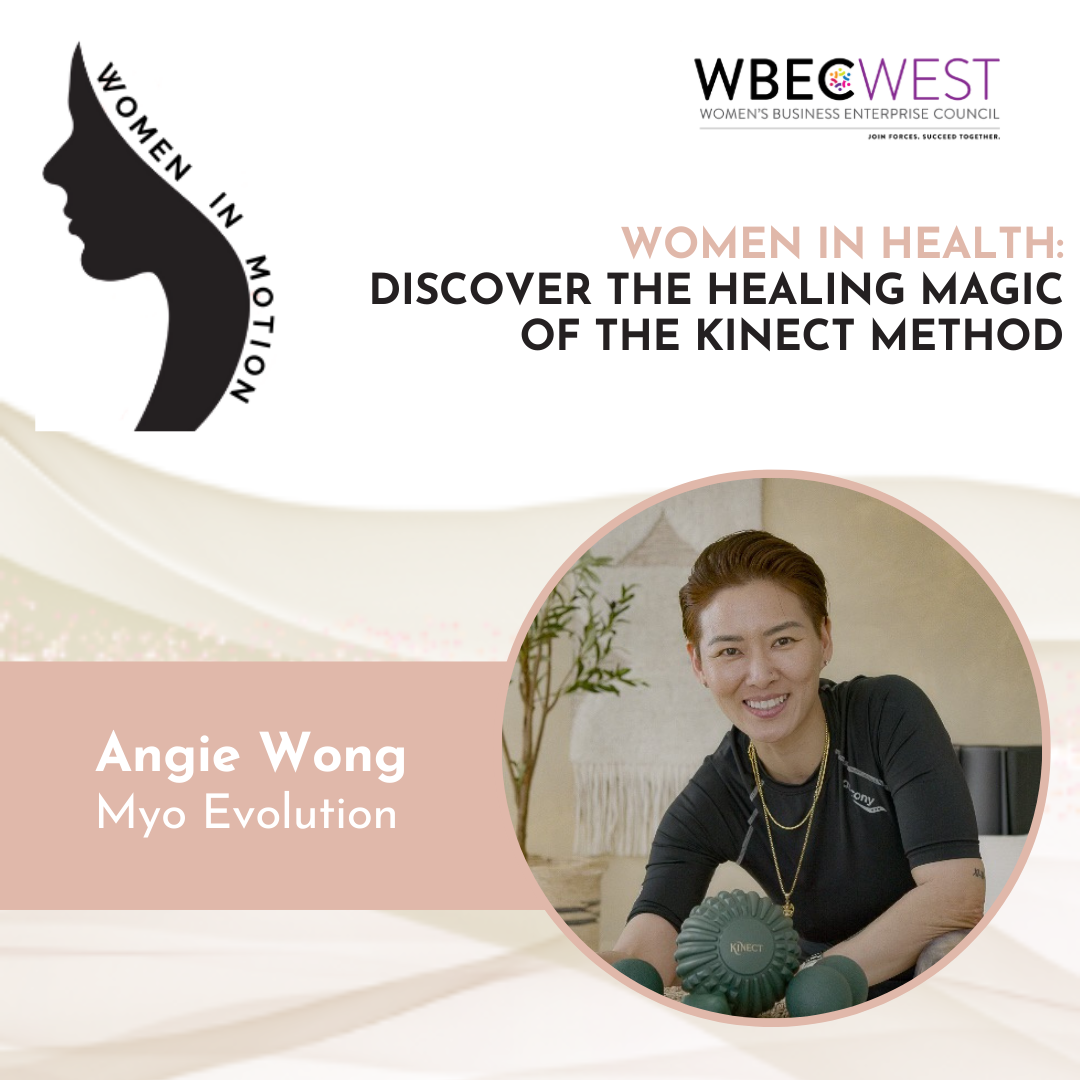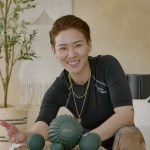
In this episode of Women in Motion, host Lee Kantor interviews Angie Wong, founder of Myo Evolution / Kinect, focusing on women’s health through myofascial release therapy. Angie explains the significance of fascia in physical and emotional well-being and introduces her Kinect Method for self-massage to alleviate pain. She shares her journey from athlete to healer, emphasizing the mind-body connection. The episode also highlights Angie’s involvement in the WBEC-West community and her innovative trigger point active release brace. Listeners gain insights into accessible self-care techniques and the importance of community support in healing.

 Angie Wong is an entrepreneur, life coach and innovative mind behind The Kinect Method, a transformational program that seamlessly integrates trigger point therapy, active release and myofascial release techniques.
Angie Wong is an entrepreneur, life coach and innovative mind behind The Kinect Method, a transformational program that seamlessly integrates trigger point therapy, active release and myofascial release techniques.
Her background as a myofascial release specialist for over 22 years has inspired her to build a holistic wellness program and became a highly sought out after massage therapist. Recognized as one of the top myofascial release specialists in Los Angeles. Angie has dedicated her career to empowering others to overcome physical and emotional barriers, unlocking their full potential for wellness and vitality. She runs her private practice, Myo Evolution and the inventor of a revolutionary active release brace called, On PAR which will be launched in 2025.
With a rich intuitive gift, her holistic approach to healing addresses the interconnectedness of mind, body and spirit, guiding clients toward physical and emotional breakthroughs. Angie’s expertise extends beyond her private practice, as she has worked with some of the most notable names in Hollywood, the music industry, dancers, professional athletes and artists.
As a dynamic speaker, Angie shares her insights on healing trauma through somatic work, the profound connection between the mind body connection and how emotional patterns shape our relational interactions and self perception. She has inspired others through her engaging, transformative facilitation through workshops and corporate events.
Driven by her passion for healing and her commitment to excellence, with over two decades of experience in the industry, Angie has positively impacted the lives of thousands, guiding them toward optimal health and well being through her energy healing and transformative approach.
Connect with Angie on LinkedIn.
Music Provided by M PATH MUSIC
![]() This transcript is machine transcribed by Sonix
This transcript is machine transcribed by Sonix
TRANSCRIPT
Intro: Broadcasting live from the Business RadioX Studios, it’s time for Women in Motion. Brought to you by WBEC-West. Join forces. Succeed together. Now, here’s your host.
Lee Kantor: Lee Kantor here. Another episode of Women in Motion. And this is going to be a good one. But before we get started, it’s important to recognize our sponsor, WBEC-West. Without them, we couldn’t be sharing these important stories.
Lee Kantor: This month we’re highlighting women in Health, and I am so excited to be talking to my next guest, Angie Wong. She is the creator and founder of Myo Evolution Kinect. Welcome.
Angie Wong : Hi, Lee. Thank you so much for having me.
Lee Kantor: Well, I am so excited to learn about what you’re up to. Tell us about Myo Evolution Kinect. How are you serving folks?
Angie Wong : Yeah. So basically, Myo Evolution is my private practice. I specialize in a modality, massage modality called myofascial release. And what that pretty much does is it addresses the connective tissue of the fascia, which is a lot of people may not know, but it interweaves throughout the entirety of our musculoskeletal system, our nerves, our organs, and pretty much the entire body.
Angie Wong : So, a lot of times when people feel physical pain, it has a lot to do with the fascia, more so than muscular. And how that interweaves with our emotions is that a lot of times, energy and emotions also can get trapped in the fascia. So that, yeah, that leads to Kinect, which is what evolved through the years of working on people’s bodies. I realized how that mind-body connection was so tied in, and really empowering people on how to literally connect with themselves on a deeper level, to address their own physical pain and learn how to release it using these self-massage tools. And yeah, it’s pretty much how it all came to life.
Lee Kantor: Now, for the layperson who obviously doesn’t know this as well as you know this, like so we have a skeleton, we have our organs in there somewhere, but then there’s the layer of muscles and then this fascia is, are they touching the muscles or are they holding the muscles to the bones. Like, how does everything kind of connect together?
Angie Wong : Yeah, it’s pretty much literally everything all the above that you said. So, the fascia goes through each muscle fiber and then it actually also covers the entire sheath of the muscle, which then of course from the muscle you have the tendon or the ligament which then attaches to the bone. So, the fascia is like the – like – it’s like a spider web. It literally runs throughout the entire system. So –
Lee Kantor: What’s its job? Like, what is – why is it there?
Angie Wong : Yeah. It basically keeps everything together. It’s like the glue ultimately. And so, a lot of times when we have muscle imbalances or injuries, what happens is that the – think of a sheet of paper. And if it’s initially flat and there’s no wrinkles or creases on it when we crumple it, now there’s right – there’s a – it’s not flat anymore. And so even if you flatten it out, the creases are still there. That’s basically what starts to happen throughout our body is that, you know, any time we injure it or hit it or move out of alignment, it starts to kind of restructure. And so, therefore, it literally has a lot to do with our posture and how our structural imbalances start to show.
Lee Kantor: So, what are kind of some of the symptoms you might be having that maybe you’ve just kind of it’s evolved to the point where you don’t notice, like you’re in a weird position or your posture is out of whack? Like, what are some of the symptoms that you might be feeling that might inspire someone to go see you or somebody that does work like you?
Angie Wong : Yeah, absolutely. So a lot of times, many of my clients have expressed that they’ve done the traditional, you know, PT, acupressure or like acupuncture, chiropractic care or stretching, and they’re faced with very limited results. So, they may have some relief. But then ultimately, it’s something that they find themselves dealing with now chronically for years. You know, they’re noticing that their chest and their shoulders are rounded and no matter what they do, it doesn’t really change. And it’s because we haven’t changed the structure of the fascia.
Angie Wong : And then even in the way that people are moving, for example, in their physical activity or on a day-to-day basis, the level of their body awareness and how they are aligned, it’s ultimately out of alignment so it continues to reinforce these very postures. And so that’s why, yeah, people experience pain, you know, or sometimes they just literally feel, and they’ve expressed this too, “I feel twisted, like something’s not right, something’s off.” And that’s literally the fascia that’s put them in a bind.
Lee Kantor: And it’ll stay in that way until something causes it not to be in that way. Is that correct?
Angie Wong : Absolutely. And that’s literally why I created the Kinect Method, because at the end of the day, no matter how often, and I find this that most people don’t really go to get massages often. They’ll say like once a month. And that’s really – I mean, yes, something is better than nothing. But the truth of the matter is we move on a daily basis, which means that self-care and these types of practices should really be done on a daily basis as much as possible to maintain the integrity of our body and for us to feel good, you know, in the long, in the long run. And so, the Kinect Method is a self-massage practice that people can do that’s more sustainable and maintainable throughout their life.
Lee Kantor: So, they can do it themselves. They don’t have to hire a professional to do it to them.
Angie Wong : Correct. I mean, the goal is that, you know, no matter what, even me as a massage therapist, I do this on a regular basis and I still do get massages because it’s kind of like the 80-20 rule. If we’re able to do 80% of the self-care and maintenance, then, you know, that 20% there’s definitely going to be parts that we cannot do ourselves no matter what. So at the very least, it would save people a lot of pain down the line, as well as prevent injuries or even avoid surgeries for that matter.
Lee Kantor: Now, is there anything you could share with the listeners right now that they can do themselves just while listening? Is there anything –
Angie Wong : Yeah, absolutely. Let’s – yeah. I love these improvised – you know, it’s great. So, if you were to ball your hand in a fist and use the knuckles, the front knuckles, or you could do honestly either or, but I typically would use the front knuckles of my fingers. And you could literally – you’re going to press it along your jaw. So for those of you who have TMJ issues. Typically, if you’re not sure where to massage, you’re going to clench your jaw really quick and you can feel that little muscle protruding out. So that’s the spot you want to hit. That’s the trigger point. And so if you just slightly gently, I say sink your knuckles into that spot and then just move up and down a little bit gently. Right?
Angie Wong : This way it’s not so aggressive, because a lot of times people use these types of tools and they just get in there, which I get the idea. It’s like, “Oh, God, I’m in so much pain. Just get in there and dig it out of me.” But, you know, we really want to be gentle because we don’t want to overstimulate the nerves or make the body feel like it’s in fight or flight.
Angie Wong : So, Lee, are you doing this with me, by the way?
Lee Kantor: I did it for a while while you were talking.
Angie Wong : Okay. Great.
Lee Kantor: But I didn’t want – I don’t want to make any –
Angie Wong : Good. How did that –
Lee Kantor: No. I noticed that – like, I definitely felt something. And it was funny that you said, don’t do it too hard because my instinct was to do it too hard. That was my first move, was, well, you got to, like you said, dig in there. If you’re going to do it, do it right. But you’re saying that you’re going to get better results if you’re gentler.
Angie Wong : Yes, it’s true because, see, because of the fact that there are all these nerve endings that are clearly intertwined with all the muscles, you can aggravate something. That’s why sometimes you’ve – some, some of you may experience where you’ve got a really nice deep tissue massage and in the moment it felt really good or maybe you were also doing a self-massage technique with the lacrosse ball on yourself and you’re just getting in there, and then the next day you’re like, “Oh, my God, wait a minute. Now I’m like, not just sore.” Soreness is natural. That can happen. But it’s like to the point where you’re like, “I can barely move my shoulder,” or like whatever area. It’s like it’s very swollen. And so, that’s the thing. You’re basically injuring your body.
Angie Wong : So, that’s why it’s a technique. It’s not just about go in and dig in and go as hard as you can. I mean, anyone can do that. So as a professional, there’s a way that we approach the body so that the body feels safe and it can receive even deeper pressure for those of you who don’t like pain and are like, “Oh, God, I hate deep tissue massages because,” that’s the reason, they may have had an experience where it was just way too aggressive.
Lee Kantor: Now, what about things like foam rollers? Or I have a foam roller. I have three foam rollers. One is kind of softer, one is kind of hard, and one has kind of bumps on it. Like, is that play into what you’re teaching?
Angie Wong : Absolutely. And the distinction between how I teach it is if you were to watch most foam rolling videos and in the way that you see people at the gym, for example, as well using the foam rollers, they’re literally rolling up and down, back and forth, back and forth. And see, the concern I have about it is that, first of all, when you’re engaged and moving that fast, there is absolutely no way your muscles are actually relaxing.
Angie Wong : So, how is it even effective to release tension when you yourself are tense the entire time, right? So you may feel the pain and you go, “Oh, gosh, it hurts.” Okay, maybe it’s working, but you don’t really see the results and the effectiveness of it.
Angie Wong : So, the way that I teach it that makes it different is that I really teach you to slow down using your body weight and your breath as a way to ease into it so that you can go a little deeper. And then once you’re in, I use these intuitive movements, just like I demonstrated with the fist. Right? And just very slowly rolling up and down. And so, you’ll actually feel relief. If you can, I would invite you to retry that, re-attempt that again. This time, just dig your knuckle in, find that tender spot, and just press ever so like – you know, you can still sink in there, but when you’re going up and down, it’s very like precise and focused on that one spot.
Lee Kantor: Now, when you’re doing it, are you going up and down then removing your hand and then going up and down again, or are you going up then down, back and forth?
Angie Wong : Yeah. So I basically – it’s like I’m sunken into that one spot and it’s more of like, I’ll go up, down, left, right, like a little almost even circular motions is okay. And sometimes I’ll even leave, like, for example, you can leave your knuckles there on that spot and then slowly open your jaw. And when you open your jaw, you can literally feel how the muscle is isolated. And that’s what I would call then a stretch. That’s an active release.
Lee Kantor: And then how long should you do one given spot like that?
Angie Wong : Yeah, I’d say it’s pretty intuitive. Typically, they say about two to three minutes. But, you know, sometimes you’re in a spot that’s just so wound up that, you know, even if you stay there for five minutes, intuitively you would know because you’d be like either thinking in your head, “Okay, when am I? When do I move?” That’s that’s probably a good sign right there. Or, you know, or you might feel like, okay, it’s a little bit too tender now. Like, now I can move along. But yeah, I would say the rule of thumb would be about two to three minutes.
Lee Kantor: Now, you’ve used the word release. I don’t know if you mentioned active release or the myofascial release. Like, is there – that connotes to me like some sort of something’s going to happen, like does something dramatically happen that when you have released something, or is it something more subtle than that?
Angie Wong : Absolutely. Well, it can be subtle and it definitely can be pretty dramatic. It just really depends on the person and the body part. So when I say release, typically what happens is, I would say, it releases the hold that it has on that specific area. So, a lot of times people once they release a trigger point, they would actually experience increased mobility. Sometimes this is whether it’s subtle or dramatic. Sometimes people literally have an emotional release. They start to cry, you know. And it’s not always crying. Some people will laugh. Everyone has a different response.
Angie Wong : The body is very wise. There’s this book, The Body Keeps the Score, and it talks about how events and emotions get – like the body remembers ultimately throughout our entire life. And, you know, in the mind when we are constantly doing, doing, doing, it’s very hard for us to keep track of like what we did sometimes, even just yesterday. So, you can only imagine all the times that you forgot, the times that you were upset or angry or hurt or sad, and all the things in between.
Angie Wong : So, sometimes what happens is someone will hit a spot and all of a sudden either, you know, sometimes a memory will come up or again an emotion, and then whatever happens happens. And I always tell the client, “Hey, there’s nothing wrong with you and there’s nothing wrong with this emotion. It’s just needing to become, you know, to be – come to the surface and addressed. And then now we can really let that go.” So, yeah.
Lee Kantor: Now, how did you – what was your journey to this spot you’re at now? Like, were you always interested in this growing up and then, you know, started doing it and then just got into it more and more? Like, how did you get to where you are? Because obviously you’re kind of at the top of your field here.
Angie Wong : Yeah. Thank you. So, I pretty much started off as an athlete. I played soccer. So, as you can imagine, there’s a lot of running, a lot of tournaments, and a lot of tension and injuries. So, I did have a natural ability with my teammates. When we would trade massages, they would always compliment how well they felt. And naturally, I also have a deep desire to help others. And so, I figured, hey, you know, this would be a great skill to have no matter what I end up doing in my life. I love massage myself. And so, I decided to get certified.
Angie Wong : And it started off very innocent in a way where when I opened my practice, I was supporting people obviously with a lot of aches and pains. And then in my own personal journey through transformational work, I started to become aware of my emotional wounds and where they rooted from, you know, ultimately from childhood. And then I realized, oh, my gosh, the mind-body connection is so real. Like, I always believed in it. But now it really clicked for me and I understood why.
Angie Wong : So, you know, and people would come in and I could just tell. I could feel their energy. I could feel the heaviness and the stress and just, you know, I mean, life is not easy. And we’re all navigating through some really challenging times and have a lot of responsibilities and a lot of events that have happened to us.
Angie Wong : And so, through the sensitivity and intuition of all of that is what evolved into me becoming a life coach to supporting people on an emotional level as well as a physical because they are connected. And again, that’s really how Kinect was born, because I go – you know, so many people are riddled with pain and whether it’s physical or emotional and both, and I really have this calling to empower people to learn this skill, because it is just so fulfilling to have on their own. I mean, pain comes in the most inconvenient times, in the middle of the night, when you’re traveling. And so if you have the skill, then you’re able to at least self-soothe and support yourself in the long run.
Lee Kantor: Now, do you remember the first time that you were working on someone and all of a sudden they had some dramatic release and you were like, wow, I’m doing this like I’m really making an impact. It must have been a little startling, I would imagine, the first time.
Angie Wong : Yeah. You know, interestingly enough, it’s funny when obviously I was a rookie and I didn’t have my practice yet, I was still working for other places like, you know, hotels and spas and different types of settings, and people would always give me just such great reviews. They’d be like, “Oh, my gosh, you know, this is like the best I’ve ever had.” And I’m thinking to myself, really? Like, are you just being nice to me? Or because, I mean, it’s a massage. Maybe that’s why – you know, who wouldn’t like it? But they tell me like, no, I literally would have some really bad experiences, whether they got injured from the massage or it felt like there was no difference.
Angie Wong : And one day, you know, I was basically, I mean, first of all, through all that feedback, I still was like, I don’t know, I’m not, I’m not sure if I really have something. I mean, I do hear this often, but maybe I just didn’t believe in myself enough at the time. But one day someone said to me, “You know, you are more than just a massage therapist. You are literally a healer.” And I was like, wow, that is like – that’s a first. And that really landed for me in a way that man, maybe all these people that were giving me this feedback were really being truthful, and I can really lean into that and own that myself.
Angie Wong : That’s really actually part of my own healing is, you know, sometimes we question our own abilities, our own gifts, and until we are able to own it. And I say this in the most humblest way because I’m always a student before I am a teacher or a master or anything of that nature. But it really just gave me such a humbling experience to hear that, and like you said, the impact that I was able to make for these people.
Angie Wong : And so, yeah, it really is my life’s work. I am so grateful to have this as a way to connect with people and make a difference in their lives.
Lee Kantor: Now, why was it important for you to become part of the WBEC-West community? What were you hoping to get out of it and what have you gotten out of it?
Angie Wong : Yeah, well, as an entrepreneur, woman entrepreneur, that is, and, you know, I’m Asian, and I’m also part of the LGBT community, there’s so many layers of being a woman and a business owner that I am just always inspired to learn from other powerful women who have achieved and accomplished things. I love to learn. I am just a – literally, I’m so passionate about learning and meeting like-minded people and this organization has been nothing short but amazing.
Angie Wong : I’m so grateful that it was brought into my radar by another member who is also an incredible woman, Wendy Close; I just want to throw her name out just because I love her. And I just felt like, yes, it was a natural, an easy yes for me. And like I said, I definitely don’t regret that decision.
Lee Kantor: Now, you have a new invention. Can you talk a little bit about that before we wrap up?
Angie Wong : Yeah. Thank you so much for asking. So, I created a – it’s a trigger point active release brace. So what that means is this particular brace is worn on the forearm because, like me, I have – as a massage therapist, right, I have clearly very tight forearms because of all the work that I do, on top of working out and just daily usage of my hands. So I thought to myself, oh, my gosh, I need something that can release this tension that’s constantly like squeezing me. So, I had that aha moment and I figured how many other people experienced forearm pain? People who are typing on the computer all the time. So, anyway, you wear this brace and it has these trigger points. So when you actively move throughout the day you are literally getting a massage.
Angie Wong : Yeah. So, I’m excited to launch that very soon. We are in the prototyping and fundraising stage, but it’s definitely a vision that I’m very, very passionate about, which I know that will help hopefully millions of people as well.
Lee Kantor: And your work, it can be obviously experienced, you know, one-on-one with you. Are there other ways that people can at least sample what you’re talking about? Are there videos or are there other types of thought leadership that you share with people who aren’t, you know, physically around you?
Angie Wong : Absolutely, yes. So, I do have a YouTube channel. It’s Kinecttoheal. And I do have a bunch of different videos on different body parts on how to self-massage. I do also offer obviously like in-person workshops, and I plan on having an online course so that we can have group coaching and I can really support people so that they do have the actual engagement with me versus just watching a video, because, you know, at the end of the day, there’s still something that’s not very personal, so I really want people to be able to also connect with me and me to support them in a more observant way, so to speak. So yeah, those are the different ways that people can work with me, for sure.
Lee Kantor: And then when they’re looking for you, Kinect. When you’re saying the word Kinect, it’s K-I-N-E-C-T.
Angie Wong : Correct. Yes. Thank you for clarifying that. And also, by the way, I do offer like corporate wellness programs and, you know, corporate events as well. So I would love to always just demonstrate, you know, the power of these simple techniques because, again, those people are just sitting in front of the computer all day and I know that their poor backs and necks are screaming for some love and attention.
Lee Kantor: And people who aren’t around you, like, you can get a foam roller or even like a tennis ball, lacrosse ball. There’s lots of things you can use to at least simulate somewhat some of the things you’re talking about, right?
Angie Wong : Absolutely. For sure. I mean, Amazon has them all day, every day. And I actually also curated my own custom massage kit that covers pretty much the entire body. And that is available on my website as well.
Lee Kantor: And what’s the website?
Angie Wong : Yes. So, the website that one is on the Myo Evolution. So it’s www.myo, M-Y-O, the word evolution, la as in Los Angeles, dot com. So, myoevolutionla.com.
Lee Kantor: Well, Angie, thank you so much for sharing your story today. You’re doing such important work and we appreciate you.
Angie Wong : My pleasure, Lee. Thank you again for your time.
Lee Kantor: All right. This is Lee Kantor. We’ll see you all next time on Women in Motion.














